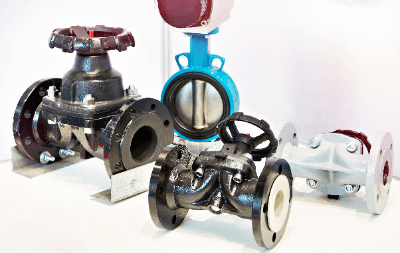What Is a Diaphragm Valve?
 A Diaphragm Valve is a valve that uses a flexible diaphragm made of rubber or other material to control the flow path.
A Diaphragm Valve is a valve that uses a flexible diaphragm made of rubber or other material to control the flow path.
Since the structure is simpler than other valves, it is possible to make a valve with excellent corrosion and chemical resistance by manufacturing the valve body with metal and lining the inside with rubber or FRP.
Uses of Valve Diaphragm Valves
Diaphragm Valves are mainly used in piping where corrosion resistance and chemical resistance are required. For this reason, they are used in chemical plants, semiconductor plants, and food factories.
For example, when corrosion resistance is required in chemical plants, the diaphragm is made of EPDM and the interior is lined with hard rubber to be used in lines with corrosive fluids such as hydrochloric acid.
In other cases, semiconductor plants handle hazardous fluids such as silane and nitrogen trifluoride, for which diaphragm valves with excellent airtightness and a simple internal shape are most suitable.
The simple structure also makes it possible to clean the production line and disassemble the valve for cleaning. Diaphragm Valves are also used in pharmaceutical manufacturing plants and bio-industries by using materials that can be sterilized, etc.
Principle of the Diaphragm Valve
The principle of the Diaphragm Valve is very simple. Instead of a valve disc component, Diaphragm Valves use a corrosion-resistant lined valve disc and a corrosion-resistant diaphragm to control the medium by moving the diaphragm.
Raising the diaphragm up opens the passage and lowering the diaphragm presses it against the valve body, closing the valve. Fluid is controlled by the vertical movement of the diaphragm only.
There is an internal structure with a weir in the flow path, which tightly fits the diaphragm to control the flow path. The valve handle itself is rotated, but the diaphragm itself only moves back and forth, so it has very few sealing parts like other valves. Therefore, it has excellent sealing performance.
Types of Diaphragm Valve
There are two types of Diaphragm Valve: manual and automatic.
Automatic Diaphragm Valves may use pneumatic, hydraulic, or electric actuators and accessories such as solenoid valves, limit switches, and positioners.
Diaphragm Valves are characterized by their excellent sealing properties due to their elasticity. Therefore, they are often used in piping for corrosive fluids and chemicals, where even the slightest leakage is not allowed.
The valve consists of a valve body, an elastomer diaphragm, and a seat for the diaphragm to close the valve.
Other Information on Diaphragm Valves
Characteristics of Diaphragm Valves
Diaphragm Valves have little external leakage and can flow hazardous fluids. Because of their simple structure, there are no parts that can cause liquid accumulation, making them especially useful in the semiconductor industry when hazardous gases must be completely discharged.
Maintenance is also very easy, as the valve body and diaphragm are the only parts other than the handle and other driving parts. No consumables exist other than the diaphragm.
On the other hand, there are some disadvantages that must be noted. Diaphragm Valves can be used in a narrow pressure range up to about 20 bar, depending on the diaphragm material, and in a temperature range from -50°C to 230°C. They cannot be used in lines that handle extremely high-temperature, high-pressure fluids. Diaphragms tend to wear out and require more frequent maintenance than conventional valves.
In addition, Diaphragm Valves have a low coefficient of flow, called the CV value, which results in a large pressure drop. Therefore, if pressure loss is a problem, especially with liquids, installing a Diaphragm Valve that is the same as the piping bore size may cause problems.